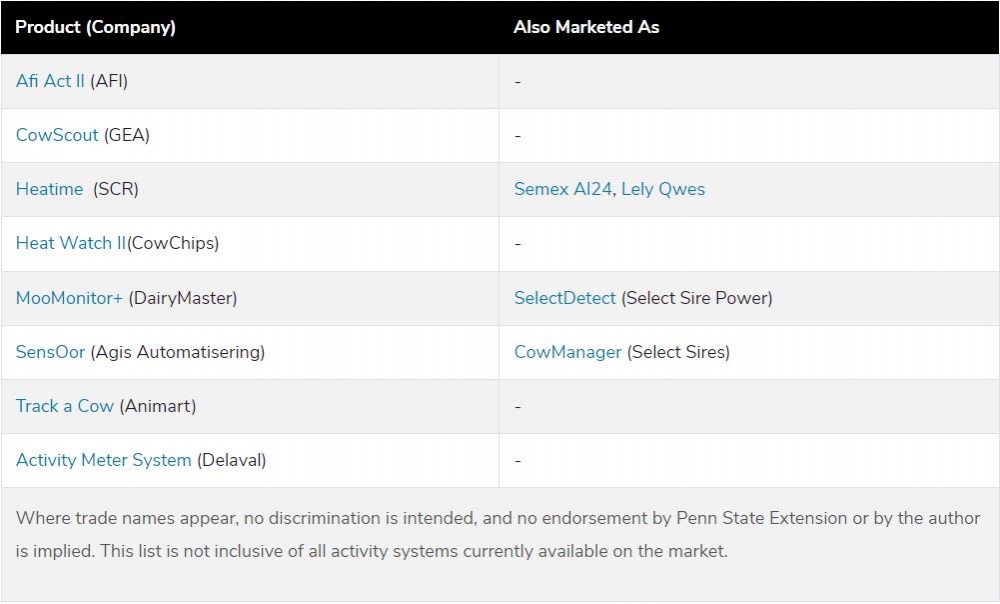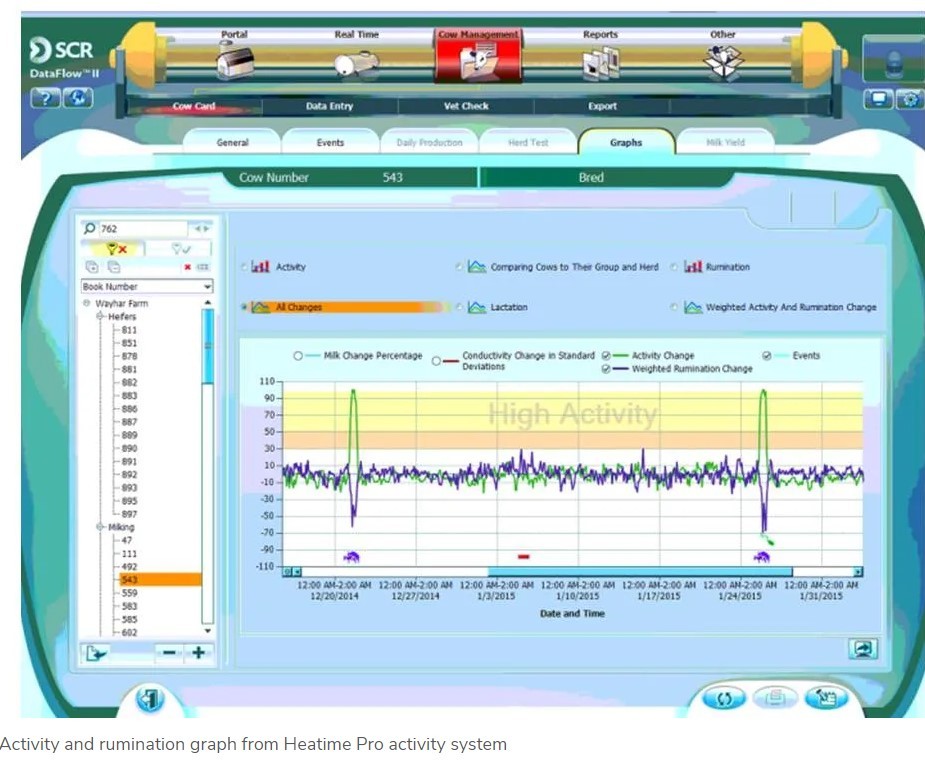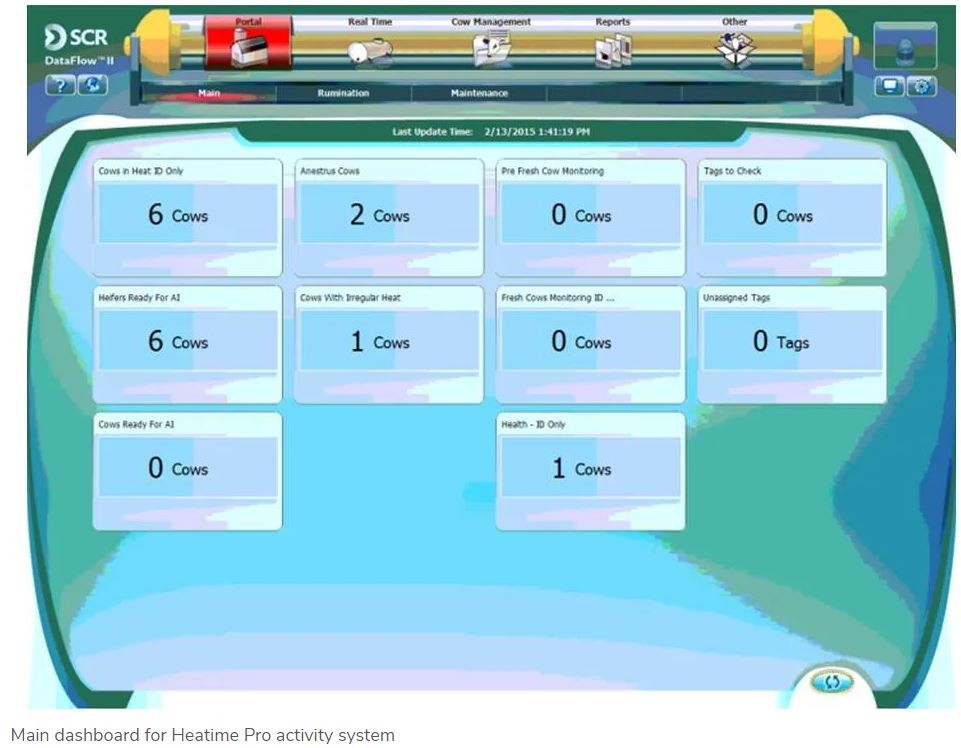Choosing an Activity System for Your Dairy - PSU Extension
Choosing an Activity System for Your Dairy
by Matthew Haan, Former Extension Dairy Educator, Pennsylvania State University
There is growing interest in the use of activity monitoring systems on dairy farms. This interest is driven by the desire to improve reproductive performance, reduce labor, and reduce the cost of production. With the growing demand, an ever-increasing number of companies are developing and marketing these systems (see the table below, click on product name to go to the company's web site). This article will address some common questions about activity systems. Where trade names appear, no discrimination is intended, and no endorsement by Penn State Extension or by the author is implied.

What do the systems consist of?
The systems typically consist of three main parts 1) an activity tag containing a pedometer or accelerometer attached to the leg, ear, or a collar on the cow's neck; 2) an antenna to read the activity tag; and 3) a computer with software that allows the dairy farmer to enter information into the system and view output from the activity tags.
What do the activity tags measure and how is that data accessed?
Very simply, the activity tags measure cow activity or movement. The computer takes this information and compares it to previously collected data to determine when a cow's activity is increasing or decreasing. The activity data is presented to the farmer in tables and graphs, and typically the number of hours until ovulation or an optimum time to insemination is also shown.

In addition to activity, many of these systems also monitor cow temperature, eating time, rumen function, and cow position (standing vs. lying). Cow activity and these other measurements are often combined to provide an overall indication of cow health. Some systems also allow the dairy farmer to locate a specific animal in the barn.
How long will it take to pay back the cost of the system?
Most companies selling the systems report a one- to two-year payback period on the cost of the system. The actual time will depend on the existing reproduction program and how well the dairy can integrate the new technology into their management system. Some areas where dairy farms obtain cost savings with the introduction of an activity system include decreased labor for watching standing heats, decreased hormone costs and labor from less use of an ovsynch program, and decreased semen costs. Revenue generation from an activity system can come from an earlier age at first calving, decreased calving interval, and an increased average milk production resulting from a decreased DIM. When activity is combined with other measures to provide a health indication, additional savings can be obtained by treating a cow before other clinical signs are observed.
How easy is the system to use?
Data from most systems can be accessed from a computer or smartphone, with some systems using a standalone terminal to view and enter data. In most cases, only basic computer skills are required to operate the system, and many companies will offer training on how to use the system. Data from the activity system can often be integrated with PCDart or other herd management software to avoid the need to enter data into multiple systems.

Will the system work on my dairy?
The activity systems can work with most management systems and most-sized dairy farms. There are examples of activity systems used on dairy farms with a 50-cow, tie-stall barn to a 900-cow, free-stall barn, and any management system in between. Some systems require a reliable internet connection.
Does every cow need an activity tag?
That will depend on how you want to use the system on your farm. For most systems, once the activity tag is on the animal it will take seven to ten days for the system to establish a baseline for that individual. If you want to use the system only for heat detection, you need enough activity tags to put one on each cow a few weeks after freshening until confirmed pregnant. If you want to use the activity tags to monitor cow health around freshening and for heat detection, you need enough activity tags for cows about one month before freshening until confirmed pregnant. If you want to use the activity tags to monitor cow health throughout her life or you do not like the idea of switching activity tags all the time, you need enough tags for the entire herd.
- What training or support is provided with the system?
- How long is the warranty period on the tags or other system components
- How large of an area will the tag reader or antenna cover? Will the system read the activity tags in all parts of the barn or pastures?
- Is there another farm in the area using the system that I could visit?
- What is the payback period for the system? Several companies have a payback calculator that allows you to enter information about your current system and provides assumptions about changes that can be expected with the system.
- Is the activity system compatible with my current herd management software?
- Do I need an internet connection for this system to work?
Upcoming Events
WEBINAR - Automated Milking Systems Efficiency: Balancing Focus on Individual Cows and System Optimization
May 8, 2024
Please join Cornell the SWNY team and MSU Extension for our talk with Dr. Pablo Silva Boloña on improving efficiency of Automated milking systems by focusing on milking settings for individual and group success.
Broiler Field Day at Sunny Cove Farm
June 6, 2024
Alfred Station, NY
Join us for a field day to explore broiler production, processing, and finances. Meghan Snyder of Sunny Cove Farm will be our host. She raises small batches of organic broilers, processing them on-farm under the 1,000 bird exemption.
Cornell Seed Growers Field Day
July 2, 2024
Ithaca, NY
Please Save the Date for the Cornell Seed Growers Field Day to be held the morning of July 2nd. The event will be held at the NYSIP Foundation Seed Barn, 791 Dryden Rd., Rt. 366, Ithaca, NY.
Announcements
No announcements at this time.





